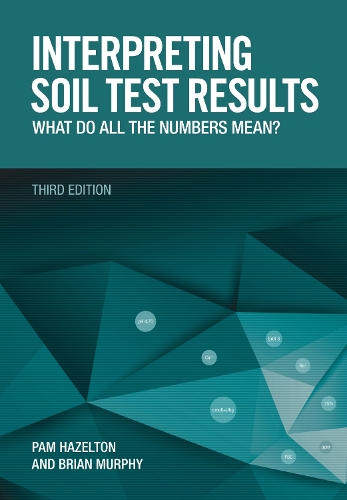
Interpreting Soil Test Results: What Do All the Numbers Mean
(Paperback, Third Edition)
Available Formats
Paperback, Third Edition
Published: 1st November 2016
Paperback, Fourth Edition
Published: 1st May 2025
Publishing Details
Interpreting Soil Test Results: What Do All the Numbers Mean
By (Author) Pam Hazelton
By (author) Brian Murphy
CSIRO Publishing
CSIRO Publishing
1st November 2016
Third Edition
Australia
Classifications
Professional and Scholarly
Non Fiction
Environmental management
Sustainable agriculture
631.42
Physical Properties
Paperback
200
Width 170mm, Height 245mm
512g
Description
Interpreting Soil Test Results is a practical reference enabling soil scientists, environmental scientists, environmental engineers, land holders and others involved in land management to better understand a range of soil test methods and interpret the results of these tests. It also contains a comprehensive description of the soil properties relevant to many environmental and natural land resource issues and investigations. This new edition has an additional chapter on soil organic carbon store estimation and an extension of the chapter on soil contamination. It also includes sampling guidelines for landscape design and a section on trace elements. The book updates and expands sections covering acid sulfate soil, procedures for sampling soils, levels of nutrients present in farm products, soil sodicity, salinity and rainfall erosivity. It includes updated interpretations for phosphorus in soils, soil pH and the cation exchange capacity of soils. Interpreting Soil Test Results is ideal reading for students of soil science and environmental science and environmental engineering; professional soil scientists, environmental scientists, engineers and consultants; and local government agencies and as a reference by solicitors and barristers for land and environment cases.
Reviews
Review of the Second Editon:
"Interpreting Soil Test Results is a handy compendium. Soil scientists who write for clients and the clients who read their reports...should find this book valuable."-- "European Journal of Soil Science"
Author Bio
Dr. Pam Hazelton has been a practicing soil scientist for over 35 years. She graduated in Science from the University of Sydney and gained her PhD for her work on semi-arid soils from the University of NSW. She was a consultant to the Soil Conservation Service, a soil surveyor in the Department of Conservation and Land Management and has worked with environmental consultants. She has been a lecturer at a variety of universities and in the Faculty of Engineering and IT at the University of Technology Sydney specifically focused on the environmental and engineering problems of urban soils. She is a former President of Soil Science Australia and also Vice President of the International Union of Soil Scientists Commission for Education in Soil Science. Dr. Brian Murphy has worked as a soil scientist for 30 years with a strong focus on applied science. He graduated in Agricultural Science from the University of Sydney, from where he also gained his Masters and his PhD for his work on soil structure in cropping systems. Dr. Murphy's interests lie in the application of soil science to environmental management, hydrology, salinity and urban land use. His work involves providing day-to-day advice on the management of soils for a range of natural resource issues. He is also an experienced researcher and has published numerous scientific papers, and is an editor of a very successful, widely used textbook, now in its third edition, on the characterization and management of soils. He is a former President of the NSW Branch of Soil Science Australia.
